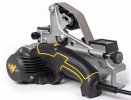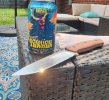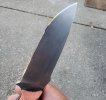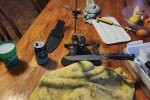hypothetically29
Gold Member
- Joined
- Feb 10, 2019
- Messages
- 111
Interested to hear everyone's thoughts on their preferred sharpening system or method, general upkeep and storage.
Context: historically, I've done a mediocre job sharpening my kitchen knives on a cheap double sided whetstone + strop, and my harder super steels on a fallkniven DC4 diamond + ceramic mini stone, + strop. I've been able to keep things relatively shaving sharp, but don't think I'm doing myself any favors with long term edge retention, stability or geometry.
In addition, I recently bought an FK2 second hand from the forum, with some very minor edge issues (a few small nicks in the belly that you can catch your finger nail on, but only see upon close inspection). The seller said the knife was unused and wasn't sure where the edge issues came from, so I'm guessing this was corrosion from improper storage? I also have another CPM 3V field knife (not CPK) that developed similar nicks in the belly after one feather stick and a few years of sitting in its leather sheath.
Disclaimer: I am not questioning the seller (all of the above was disclosed upfront) or CPK's quality (I have an FK3 on the way direct from their last sale and am looking forward to acquiring more CPKs in the future). I'm questioning my own skills and knowledge on knives.
What I want to know is - how do you maintain your knives? Do you oil the blades when in storage? What's your favorite guided sharpening system? Any other tips and tricks from the hard users as well as collectors on here?
Context: historically, I've done a mediocre job sharpening my kitchen knives on a cheap double sided whetstone + strop, and my harder super steels on a fallkniven DC4 diamond + ceramic mini stone, + strop. I've been able to keep things relatively shaving sharp, but don't think I'm doing myself any favors with long term edge retention, stability or geometry.
In addition, I recently bought an FK2 second hand from the forum, with some very minor edge issues (a few small nicks in the belly that you can catch your finger nail on, but only see upon close inspection). The seller said the knife was unused and wasn't sure where the edge issues came from, so I'm guessing this was corrosion from improper storage? I also have another CPM 3V field knife (not CPK) that developed similar nicks in the belly after one feather stick and a few years of sitting in its leather sheath.
Disclaimer: I am not questioning the seller (all of the above was disclosed upfront) or CPK's quality (I have an FK3 on the way direct from their last sale and am looking forward to acquiring more CPKs in the future). I'm questioning my own skills and knowledge on knives.
What I want to know is - how do you maintain your knives? Do you oil the blades when in storage? What's your favorite guided sharpening system? Any other tips and tricks from the hard users as well as collectors on here?





